Optical Measurement System for Monitoring Railway Infrastructure—A Review
Abstract
:1. Introduction
2. Optical Inspection Technologies in Railways
2.1. Overview
2.2. Monitoring Subjects
2.3. Sensor Systems
2.3.1. Sleepers
2.3.2. Track
2.3.3. Vegetation
2.3.4. Pantographs

2.3.5. Contact Wire
2.3.6. Pole
2.3.7. Tunnel
2.3.8. Clearance
2.3.9. Wheels
2.3.10. Rolling Stock
3. Robotic and Autonomous Inspection
4. Data Analysis and Evaluation by AI
5. Discussion
6. Conclusions and Outlook
Author Contributions
Funding
Institutional Review Board Statement
Informed Consent Statement
Data Availability Statement
Conflicts of Interest
References
- Mattsson, L.-G.; Jenelius, E. Vulnerability and resilience of transport systems—A discussion of recent research. Transp. Res. Part A Policy Pract. 2015, 81, 16–34. [Google Scholar] [CrossRef]
- Dobney, K.; Baker, C.J.; Quinn, A.D.; Chapman, L. Quantifying the effects of high summer temperatures due to climate change on buckling and rail related delays in south-east United Kingdom. Meteorol. Appl. 2009, 16, 245–251. [Google Scholar] [CrossRef]
- Oslakovic, I.S.; ter Maat, H.; Hartmann, A.; Dewulf, G. Risk Assessment of Climate Change Impacts on Railway Infrastructure. In Proceedings of the EPOC 2013 Conference—Engineering Project Organization Conference, Devil’s Thumb Range, CO, USA, 9–11 July 2013; pp. 9–11. [Google Scholar]
- Trimble Inc. GEDO Vorsys: Pre-Measurment for Tamping. 2022. Available online: https://download.trimble-railway.com/download/#498-950-gedo-vorsys-system (accessed on 3 April 2024).
- Leica Geosystems AG. SiTrack:One. Available online: https://www.google.com/url?sa=t&source=web&rct=j&opi=89978449&url=https://leica-geosystems.com/-/media/files/leicageosystems/products/datasheets/sitrack_one_by_leica_geosystems_ds.ashx%3Fla%3Den%26hash%3DBF4BD4D2D7B19F6983B9A29E72F2F5CE&ved=2ahUKEwiHyamJmeCIAxVwc_EDHdvuEoYQFnoECBQQAQ&usg=AOvVaw0nXG_UtLaP7ndGDbmwTl9- (accessed on 26 September 2024).
- Hisa, T.; Kanaya, M.; Sakai, M.; Hamaoka, K. Rail and contact line inspection technology for safe and reliable railway traffic. Hitachi Review 2012, 61, 325–330. [Google Scholar]
- Wirth, H. Der neue Lichtraummesszug LIMEZ III der Deutschen Bahn AG. ZfV 2008, 133, 180–186. [Google Scholar]
- Wikipedia. China Railway Comprehensive Inspection Trains. Available online: https://en.wikipedia.org/w/index.php?title=China_Railway_comprehensive_inspection_trains&oldid=1219488938 (accessed on 24 June 2024).
- Li, Q.; Ren, S. A Real-Time Visual Inspection System for Discrete Surface Defects of Rail Heads. IEEE Trans. Instrum. Meas. 2012, 61, 2189–2199. [Google Scholar] [CrossRef]
- Papaelias, M.P.; Roberts, C.; Davis, C.L. A review on non-destructive evaluation of rails: State-of-the-art and future development. Proc. Inst. Mech. Eng. Part F J. Rail Rapid Transit 2008, 222, 367–384. [Google Scholar] [CrossRef]
- Reiterer, A.; Höfler, H.; Wölfelschneider, H.; Baulig, C.; Maindorfer, I.; Dimopoulos, N.; Schwarzer, S.; Dambacher, M. Railway Measurement Techniques: Opportunities and Challenges. In Proceedings of the Second International Conference on Railway Technology: Research, Development and Maintenance, Ajaccio, Corsica, France, 8–11 April 2014; Pombo, J., Ed.; Civil-Comp Press: Stirlingshire, UK, 2014. [Google Scholar]
- Soilán, M.; Sánchez-Rodríguez, A.; Del Río-Barral, P.; Perez-Collazo, C.; Arias, P.; Riveiro, B. Review of Laser Scanning Technologies and Their Applications for Road and Railway Infrastructure Monitoring. Infrastructures 2019, 4, 58. [Google Scholar] [CrossRef]
- Du, C.; Dutta, S.; Kurup, P.; Yu, T.; Wang, X. A review of railway infrastructure monitoring using fiber optic sensors. Sens. Actuators A Phys. 2020, 303, 111728. [Google Scholar] [CrossRef]
- Kerr, A. Fundamentals Of Railway Track Engineering; Simmons Boardman Pub Co.: Omaha, NE, USA, 2003. [Google Scholar]
- Ferdous, W.; Manalo, A. Failures of mainline railway sleepers and suggested remedies—Review of current practice. Eng. Fail. Anal. 2014, 44, 17–35. [Google Scholar] [CrossRef]
- Werner, C.S.; Frey, S.; Reiterer, A. Automated visual vegetation detection for weed management on transportation infrastructure. In SPIE Optical Metrology; Automated Visual Inspection and Machine Vision V; SPIE: München, Germany, 2023; pp. 114–119. [Google Scholar]
- Wu, G.; Dong, K.; Xu, Z.; Xiao, S.; Wei, W.; Chen, H.; Li, J.; Huang, Z.; Li, J.; Gao, G.; et al. Pantograph–catenary electrical contact system of high-speed railways: Recent progress, challenges, and outlooks. Rail. Eng. Sci. 2022, 30, 437–467. [Google Scholar] [CrossRef]
- Brahimi, M.; Medjaher, K.; Leouatni, M.; Zerhouni, N. Prognostics and Health Management for an Overhead Contact Line System—A Review. Int. J. Progn. Health Manag. 2017, 8, 1–16. [Google Scholar] [CrossRef]
- Song, Y.; Zhang, M.; Øiseth, O.; Rønnquist, A. Wind deflection analysis of railway catenary under crosswind based on nonlinear finite element model and wind tunnel test. Mech. Mach. Theory 2022, 168, 104608. [Google Scholar] [CrossRef]
- bvSys Bildverarbeitungssysteme GmbH. CrackCheck—bvSys Bildverabeitungssysteme GmbH. Available online: https://www.bvsys.de/54.html (accessed on 23 April 2024).
- MER MEC S.p.A. Track Inspection System V-CUBE. Available online: https://www.mermecgroup.com/measurement-br-trains-e-systems/track-inspection/524/track-inspection-v-cube.php (accessed on 5 June 2024).
- MER MEC S.p.A. Track Geometry Measurement Systems. Available online: https://www.mermecgroup.com/measurement-br-trains-e-systems/track-measurement/185/track-geometry.php (accessed on 23 April 2024).
- Fraunhofer IPM. Track Geometry Measurement System TGM, Freiburg. 2024. Available online: https://www.ipm.fraunhofer.de/content/dam/ipm/en/PDFs/product-information/OF/MTS/Track-Geometry-Measurement-System-TGM.pdf (accessed on 26 September 2024).
- TVEMA. Track Geometry Assessment Systems|JSC «Firma Tvema». Available online: https://tvema.com/638 (accessed on 23 April 2024).
- SelectraVision. Measuring TRACKS—on VEHICLE: On VEHICLE Solutions for Tracks Measurement. Available online: https://www.selectravision.com/tracks-vehicle.php (accessed on 22 April 2024).
- bvSys Bildverarbeitungssysteme GmbH. VegetationCheck—bvSys Bildverabeitungssysteme GmbH. Available online: https://www.bvsys.de/60.html (accessed on 23 April 2024).
- Fraunhofer IPM. Weed Detection System: Automatisierte Vegetationskontrolle, Freiburg. 2022. Available online: https://www.ipm.fraunhofer.de/content/dam/ipm/de/PDFs/produktblaetter/OF/AUS/Weed-detection-system-Vegetationskontrolle-automatisiert.pdf (accessed on 26 September 2024).
- SelectraVision. Measuring TRAIN | Pantocheck: PantoCheck, Pantograph measuring system: OVERVIEW. Available online: https://www.selectravision.com/products-pantocheck.php (accessed on 22 April 2024).
- bvSys Bildverarbeitungssysteme GmbH. CatenaryCheck—bvSys Bildverabeitungssysteme GmbH. Available online: https://www.bvsys.de/62.html (accessed on 23 April 2024).
- bvSys Bildverarbeitungssysteme GmbH. WireCheck—bvSys Bildverabeitungssysteme GmbH. Available online: https://www.bvsys.de/63.html (accessed on 23 April 2024).
- MER MEC S.p.A. Geometry & Contact Wire Wear Measurement System. Available online: https://www.mermecgroup.com/measurement-br-trains-e-systems/catenary-measurement/78/geometry-e-contact-wire-wear.php (accessed on 23 April 2024).
- SelectraVision. CAT-V Equipment for Catenary Geometry Measurement for Vehicle Installation. Available online: https://www.selectravision.com/cat-vehicle.php (accessed on 22 April 2024).
- Fraunhofer IPM. Contact Wire Inspection System CIS, Freiburg. 2021. Available online: https://www.ipm.fraunhofer.de/content/dam/ipm/en/PDFs/product-information/OF/MTS/Contact-Wire-Inspection-System-CIS.pdf (accessed on 26 September 2024).
- Fraunhofer IPM. Contact Wire Recording System (CRS), Freiburg. 2023. Available online: https://www.ipm.fraunhofer.de/content/dam/ipm/en/PDFs/product-information/OF/MTS/Contact-Wire-Recording-System-CRS.pdf (accessed on 26 September 2024).
- Fraunhofer IPM. Wire Wear Monitoring System (WWS), Freiburg. 2022. Available online: https://www.ipm.fraunhofer.de/content/dam/ipm/en/PDFs/product-information/OF/MTS/Wire-wear-monitoring-system-WWS.pdf (accessed on 26 September 2024).
- MER MEC S.p.A. Pole Detection System. Available online: https://www.mermecgroup.com/measurement-br-trains-e-systems/catenary-inspection/1027/pole-detection.php (accessed on 23 April 2024).
- Fraunhofer IPM. Laser Pole Detection System (LPS), Freiburg. 2022. Available online: https://www.ipm.fraunhofer.de/content/dam/ipm/en/PDFs/product-information/OF/MTS/Laser-Pole-Detection-System-LPS.pdf (accessed on 26 September 2024).
- dibit Messtechnik. The System That Defines the Standard DIBIT TSC—Tunnel Scanner: DIBIT TSC—Tunnel Scanner. Available online: https://www.dibit.at/fileadmin/user_upload/TSC_allgemein_engl_V11.pdf (accessed on 18 April 2024).
- MER MEC S.p.A. Tunnel und Spielraum Vermessungssysteme. Available online: https://www.mermecgroup.com/de/inspizieren/schienenvermessung/1028/tunnel-und-spielraum.php (accessed on 23 April 2024).
- Pavemetrics. Scanning System Laser Tunnel (LTSS). Available online: https://www.pavemetrics.com/wp-content/uploads/2020/01/LTSS-Flyer-LR.pdf (accessed on 28 May 2024).
- TVEMA. Clearance Envelope Inspection Systems|JSC «Firma Tvema». Available online: https://tvema.com/641 (accessed on 22 April 2024).
- Fraunhofer IPM. Tunnel Inspection System: Simultaneous Geometry and Moisture Measurement, Freiburg. 2022. Available online: https://www.ipm.fraunhofer.de/de/gf/objekterfassung-laserscanning/anw/bahnmesstechnik/tunnelzustand.html (accessed on 26 September 2024).
- Fraunhofer IPM. High Speed Profiler: Measuring Geometrical Changes of Structure Gauge, Freiburg. 2022. Available online: https://www.ipm.fraunhofer.de/content/dam/ipm/en/PDFs/product-information/OF/MTS/High-Speed-Profiler-HSP.pdf (accessed on 26 September 2024).
- RIEGL Laser Measurement Systems GmbH. RIEGL VMX-RAIL. 2023. Available online: http://www.riegl.com/nc/products/mobile-scanning/produktdetail/product/scanner/67/ (accessed on 31 May 2024).
- Zoller & Fröhlich GmbH. Mobile Mapping: Zoller+Fröhlich. Available online: https://www.zofre.de/en/laser-scanners/laserscanning/mobile-mapping (accessed on 4 June 2024).
- MER MEC S.p.A. Wheel Parameters Measurement Systems. Available online: https://www.mermecgroup.com/measurement-br-trains-e-systems/train-monitoring/87/wheel-parameters.php (accessed on 23 April 2024).
- SelectraVision. Wheel Profile & Diameter Measuring System. Available online: https://www.selectravision.com/wheels.php (accessed on 22 April 2024).
- MER MEC S.p.A. Train Profile Measurement Systems. Available online: https://www.mermecgroup.com/measurement-br-trains-e-systems/train-monitoring/1022/train-profile.php (accessed on 29 May 2024).
- Fraunhofer IPM. Sector Profile Scanner (SPS), Freiburg. 2022. Available online: https://www.ipm.fraunhofer.de/content/dam/ipm/en/PDFs/product-information/OF/MTS/Sector-Profile-Scanner-SPS.pdf (accessed on 26 September 2024).
- You, R.; Li, D.; Ngamkhanong, C.; Janeliukstis, R.; Kaewunruen, S. Fatigue Life Assessment Method for Prestressed Concrete Sleepers. Front. Built Environ. 2017, 3, 68. [Google Scholar] [CrossRef]
- Siahkouhi, M.; Wang, J.; Han, X.; Aela, P.; Ni, Y.-Q.; Jing, G. Railway ballast track hanging sleeper defect detection using a smart CNT self-sensing concrete railway sleeper. Constr. Build. Mater. 2023, 399, 132487. [Google Scholar] [CrossRef]
- Jing, G.; Siahkouhi, M.; Riley Edwards, J.; Dersch, M.S.; Hoult, N.A. Smart railway sleepers—A review of recent developments, challenges, and future prospects. Constr. Build. Mater. 2021, 271, 121533. [Google Scholar] [CrossRef]
- Li, J.; Doh, S.I.; Manogaran, R. Detection and Maintenance for Railway Track Defects: A Review. IOP Conf. Ser. Earth Environ. Sci. 2023, 1140, 12011. [Google Scholar] [CrossRef]
- Circelli, M.; Kaviani, N.; Licciardello, R.; Ricci, S.; Rizzetto, L.; Arabani, S.S.; Shi, D. Track geometry monitoring by an on-board computer-vision-based sensor system. Transp. Res. Procedia 2023, 69, 257–264. [Google Scholar] [CrossRef]
- Cannon, D.F.; Edel, K.-O.; Grassie, S.L.; Sawley, K. Rail defects: An overview. Fatigue Fract. Eng. Mat. Struct. 2003, 26, 865–886. [Google Scholar] [CrossRef]
- Reiterer, A.; Dimopoulus, N.; Frey, S.; Werner, C.S. Nachhaltige Vegetationskontrolle. EI-Eisenbahn Ingenieur 2020, 32–34. [Google Scholar]
- Yi, C.; Wang, D.; Zhou, L.; Lin, J. A simulation investigation on the influence of pantograph crack defect on graphite contact strip wear. Eng. Fail. Anal. 2022, 131, 105889. [Google Scholar] [CrossRef]
- Landi, A.; Menconi, L.; Sani, L. Hough transform and thermo-vision for monitoring pantograph-catenary system. Proc. Inst. Mech. Eng. Part F J. Rail Rapid Transit 2006, 220, 435–447. [Google Scholar] [CrossRef]
- Kuźnar, M.; Lorenc, A.; Kaczor, G. Pantograph Sliding Strips Failure-Reliability Assessment and Damage Reduction Method Based on Decision Tree Model. Materials 2021, 14, 5743. [Google Scholar] [CrossRef] [PubMed]
- SelectraVision. Measuring Catenary|on Vehicle|CAT-VW. Available online: https://www.selectravision.com/products-cat-vw.php (accessed on 4 June 2024).
- Fraunhofer IPM. Low Speed Contact Wire Inspection System CIS-LS, Freiburg. 2021. Available online: https://www.ipm.fraunhofer.de/content/dam/ipm/en/PDFs/product-information/OF/MTS/Contact-Wire-Inspection-System-CIS-LS.pdf (accessed on 26 September 2024).
- Arastounia, M.; Lichti, D.D. Simultaneous identification, modeling and registration refinement of poles using laser scanning point clouds. ISPRS J. Photogramm. Remote Sens. 2021, 181, 327–344. [Google Scholar] [CrossRef]
- Liu, T.; Chang, L.; Niu, X.; Liu, J. Pole-Like Object Extraction and Pole-Aided GNSS/IMU/LiDAR-SLAM System in Urban Area. Sensors 2020, 20, 7145. [Google Scholar] [CrossRef] [PubMed]
- Mett, M.; Eder, S. 3D tunnel inspection with photogrammetric and hybrid systems. In Proceedings of the Conference: Shotcrete for Underground Support XIV, Pattaya, Thailand, 17–20 November 2019. [Google Scholar]
- Vierhub-Lorenz, V.; Predehl, K.; Wolf, S.; Werner, C.S.; Kühnemann, F.; Reiterer, A. A multispectral tunnel inspection system for simultaneous moisture and shape detection. In Proceedings of the Remote Sensing Technologies and Applications in Urban Environments IV, Strasbourg, France, 9–12 September 2019; Erbertseder, T., Ed.; SPIE: Bellingham, DC, USA, 2019; p. 32, ISBN 9781510630178. [Google Scholar]
- Vierhub-Lorenz, V.; Kellner, M.; Zipfel, O.; Reiterer, A. A Study on the Effect of Multispectral LiDAR Data on Automated Semantic Segmentation of 3D-Point Clouds. Remote Sens. 2022, 14, 6349. [Google Scholar] [CrossRef]
- Fraunhofer IPM. Clearance Profile Scanner (CPS): Measuring Geometrical Changes of Structure Gauge; 2022; Available online: https://www.schienenverkehrsportal.de/download.php?TblName=asm_companyproduct_download&DownloadID=493 (accessed on 12 September 2024).
- Zucarelli, T.A.; Vieira, M.A.; Moreira Filho, L.A.; Reis, D.; Reis, L. Failure analysis in railway wheels. Procedia Struct. Integr. 2016, 1, 212–217. [Google Scholar] [CrossRef]
- Emoto, T.; Ravankar, A.A.; Ravankar, A.; Emaru, T.; Kobayashi, Y. Automatic inspection of wheel surface defects using a combination of laser sensors and machine vision. SICE J. Control Meas. Syst. Integr. 2024, 17, 57–66. [Google Scholar] [CrossRef]
- Shaikh, M.Z.; Ahmed, Z.; Chowdhry, B.S.; Baro, E.N.; Hussain, T.; Uqaili, M.A.; Mehran, S.; Kumar, D.; Shah, A.A. State-of-the-Art Wayside Condition Monitoring Systems for Railway Wheels: A Comprehensive Review. IEEE Access 2023, 11, 13257–13279. [Google Scholar] [CrossRef]
- Vaičiūnas, G.; Bureika, G.; Steišūnas, S. Measurement Repeatability of Rail Wheel Loads Caused by Rolling Surface Damages. Appl. Sci. 2023, 13, 4474. [Google Scholar] [CrossRef]
- SBB AG. Train Monitoring and Measuring Systems|SBB. Available online: https://bahninfrastruktur.sbb.ch/en/products-and-services/bahnbetrieb/train-monitoring-systems/measuring-systems.html (accessed on 31 May 2024).
- Vithanage, R.K.W.; Harrison, C.S.; DeSilva, A.K.M. Importance and Applications of Robotic and Autonomous Systems (RAS) in Railway Maintenance Sector: A Review. Computers 2019, 8, 56. [Google Scholar] [CrossRef]
- Iyer, S.; Velmurugan, T.; Gandomi, A.H.; Noor Mohammed, V.; Saravanan, K.; Nandakumar, S. Structural health monitoring of railway tracks using IoT-based multi-robot system. Neural Comput. Appl. 2021, 33, 5897–5915. [Google Scholar] [CrossRef]
- ANYbotics and Stadler Service AG Explore the Future of Train Maintenance—ANYbotics. Robotic Inspection for Rail Transport. Available online: https://www.anybotics.com/industries/robotic-inspection-railway-transportation/ (accessed on 27 May 2024).
- Loccioni. Railway—Loccioni. Available online: https://www.loccioni.com/en/railway/ (accessed on 4 July 2024).
- Our Platform—Rail Pod Inc. Available online: https://www.rail-pod.com/our-platform/ (accessed on 4 July 2024).
- Railway-News. Railway Inspection Robot Takes on Maintenance Challenges. Available online: https://railway-news.com/railway-inspection-robot-takes-on-maintenance-challenges/ (accessed on 4 July 2024).
- Atack, P.R. Japanese Railway Introduces Infrastructure Robot. Railway Technology [Online]. 4 July 2024. Available online: https://www.railway-technology.com/news/japanese-railway-introduces-infrastructure-robot/ (accessed on 5 July 2024).
- Dimec, M.; Kraljević, M.; Žalik, B.; Krejan, M.; Pečnik, S.; Podgorelec, D. Use of LiDAR and autonomous mobile robots in safety and inspection applications on railways. In Proceedings of the Rail Infrastructur Monitoring, Maintenance and Optimization, 7th International Conference on Road and Rail Infrastructure, Pula, Croatia, 11–13 May 2022. [Google Scholar]
- Jing, G.; Qin, X.; Wang, H.; Deng, C. Developments, challenges, and perspectives of railway inspection robots. Autom. Constr. 2022, 138, 104242. [Google Scholar] [CrossRef]
- Nordic Unmanned. Rail Services—Nordic Unmanned. Available online: https://nordicunmanned.com/de/services/rail/ (accessed on 4 July 2024).
- Andert, F.; Kornfeld, N.; Nikodem, F.; Li, H.; Kluckner, S.; Gruber, L.; Kaiser, C. Zustandsüberwachung von Bahnoberleitungen mit Kameradrohnen. EI-Der Eisenbahningenieur 2020, 10–14. Available online: https://elib.dlr.de/134914/1/EI_2020_05_10_16_Andert_Kornfeld.pdf (accessed on 12 September 2024).
- Jung, J.T.; Merkle, D.; Reiterer, A. Automated Camera Pose Generation for High-Resolution 3D Reconstruction of Bridges by Unmanned Aerial Vehicles. Remote Sens. 2024, 16, 1393. [Google Scholar] [CrossRef]
- Jung, S.; Song, S.; Kim, S.; Park, J.; Her, J.; Roh, K.; Myung, H. Toward Autonomous Bridge Inspection: A framework and experimental results. In Proceedings of the 2019 16th International Conference on Ubiquitous Robots (UR), Jeju, Republic of Korea, 24–27 June 2019; IEEE: Piscataway, NJ, USA, 2019; pp. 208–211, ISBN 978-1-7281-3232-7. [Google Scholar]
- Stemmler, S.; Kaufmann, T.; Bange, M.J.; Merkle, D.; Reiterer, A.; Klemt-Albert, K.; Marx, S. Multisource-data-fusion for the digitization of critical infrastructural elements. In Proceedings of the Remote Sensing Technologies and Applications in Urban Environments VII, Berlin, Germany, 5–8 September 2022; Erbertseder, T., Chrysoulakis, N., Zhang, Y., Eds.; SPIE: Bellingham, DC, USA, 2022; p. 4, ISBN 9781510655416. [Google Scholar]
- Rahman, M.; Liu, H.; Cardenas, I.D.; Starr, A.; Hall, A.; Anderson, R. A Review on the Prospects of Mobile Manipulators for Smart Maintenance of Railway Track. Appl. Sci. 2023, 13, 6484. [Google Scholar] [CrossRef]
- Kaplan, A.; Haenlein, M. Siri, Siri, in my hand: Who’s the fairest in the land? On the interpretations, illustrations, and implications of artificial intelligence. Bus. Horiz. 2019, 62, 15–25. [Google Scholar] [CrossRef]
- Phusakulkajorn, W.; Núñez, A.; Wang, H.; Jamshidi, A.; Zoeteman, A.; Ripke, B.; Dollevoet, R.; de Schutter, B.; Li, Z. Artificial intelligence in railway infrastructure: Current research, challenges, and future opportunities. Intell. Transp. Infrastruct. 2023, 2, liad016. [Google Scholar] [CrossRef]
- Krier, P.; White, B.T.; Ferriday, P.; Watson, M.; Buckley-Johnstone, L.; Lewis, R.; Lanigan, J.L. Vehicle-based cryogenic rail cleaning: An alternative solution to ‘leaves on the line’. Proc. Inst. Civ. Eng.-Civ. Eng. 2021, 174, 176–182. [Google Scholar] [CrossRef]
- Sonagra, R. Using Cryogenics to Blast Leaves from the Line. Network Rail [Online]. 9 November 2023. Available online: https://www.networkrail.co.uk/stories/using-cryogenics-to-blast-leaves-from-the-line/ (accessed on 17 April 2024).
- Tang, R.; de Donato, L.; Besinović, N.; Flammini, F.; Goverde, R.M.; Lin, Z.; Liu, R.; Tang, T.; Vittorini, V.; Wang, Z. A literature review of Artificial Intelligence applications in railway systems. Transp. Res. Part C Emerg. Technol. 2022, 140, 103679. [Google Scholar] [CrossRef]
- Di Summa, M.; Griseta, M.E.; Mosca, N.; Patruno, C.; Nitti, M.; Renò, V.; Stella, E. A Review on Deep Learning Techniques for Railway Infrastructure Monitoring. IEEE Access 2023, 11, 114638–114661. [Google Scholar] [CrossRef]
- Aydin, I.; Akin, E.; Karakose, M. Defect classification based on deep features for railway tracks in sustainable transportation. Appl. Soft Comput. 2021, 111, 107706. [Google Scholar] [CrossRef]
- Jamshidi, A.; Faghih-Roohi, S.; Hajizadeh, S.; Núñez, A.; Babuska, R.; Dollevoet, R.; Li, Z.; de Schutter, B. A Big Data Analysis Approach for Rail Failure Risk Assessment. Risk Anal. 2017, 37, 1495–1507. [Google Scholar] [CrossRef] [PubMed]
- Gibert, X.; Patel, V.M.; Chellappa, R. Deep Multi-task Learning for Railway Track Inspection. IEEE Trans. Intell. Transp. Syst. 2015, 18, 153–164. [Google Scholar] [CrossRef]
- Zhuang, L.; Wang, L.; Zhang, Z.; Tsui, K.L. Automated vision inspection of rail surface cracks: A double-layer data-driven framework. Transp. Res. Part C Emerg. Technol. 2018, 92, 258–277. [Google Scholar] [CrossRef]
- Chen, J.; Liu, Z.; Wang, H.; Nunez, A.; Han, Z. Automatic Defect Detection of Fasteners on the Catenary Support Device Using Deep Convolutional Neural Network. IEEE Trans. Instrum. Meas. 2018, 67, 257–269. [Google Scholar] [CrossRef]
- Zhong, J.; Liu, Z.; Han, Z.; Han, Y.; Zhang, W. A CNN-Based Defect Inspection Method for Catenary Split Pins in High-Speed Railway. IEEE Trans. Instrum. Meas. 2019, 68, 2849–2860. [Google Scholar] [CrossRef]
- Wu, C. Catenary components state detection method based on the dimension reduction-kernel extreme learning machine. Infrared Phys. Technol. 2024, 136, 105079. [Google Scholar] [CrossRef]
- Kang, G.; Gao, S.; Yu, L.; Zhang, D. Deep Architecture for High-Speed Railway Insulator Surface Defect Detection: Denoising Autoencoder With Multitask Learning. IEEE Trans. Instrum. Meas. 2019, 68, 2679–2690. [Google Scholar] [CrossRef]
- European Commission: Mobility and Transport. ETCS Levels and Modes. Available online: https://transport.ec.europa.eu/transport-modes/rail/ertms/what-ertms-and-how-does-it-work/etcs-levels-and-modes_en (accessed on 29 July 2024).



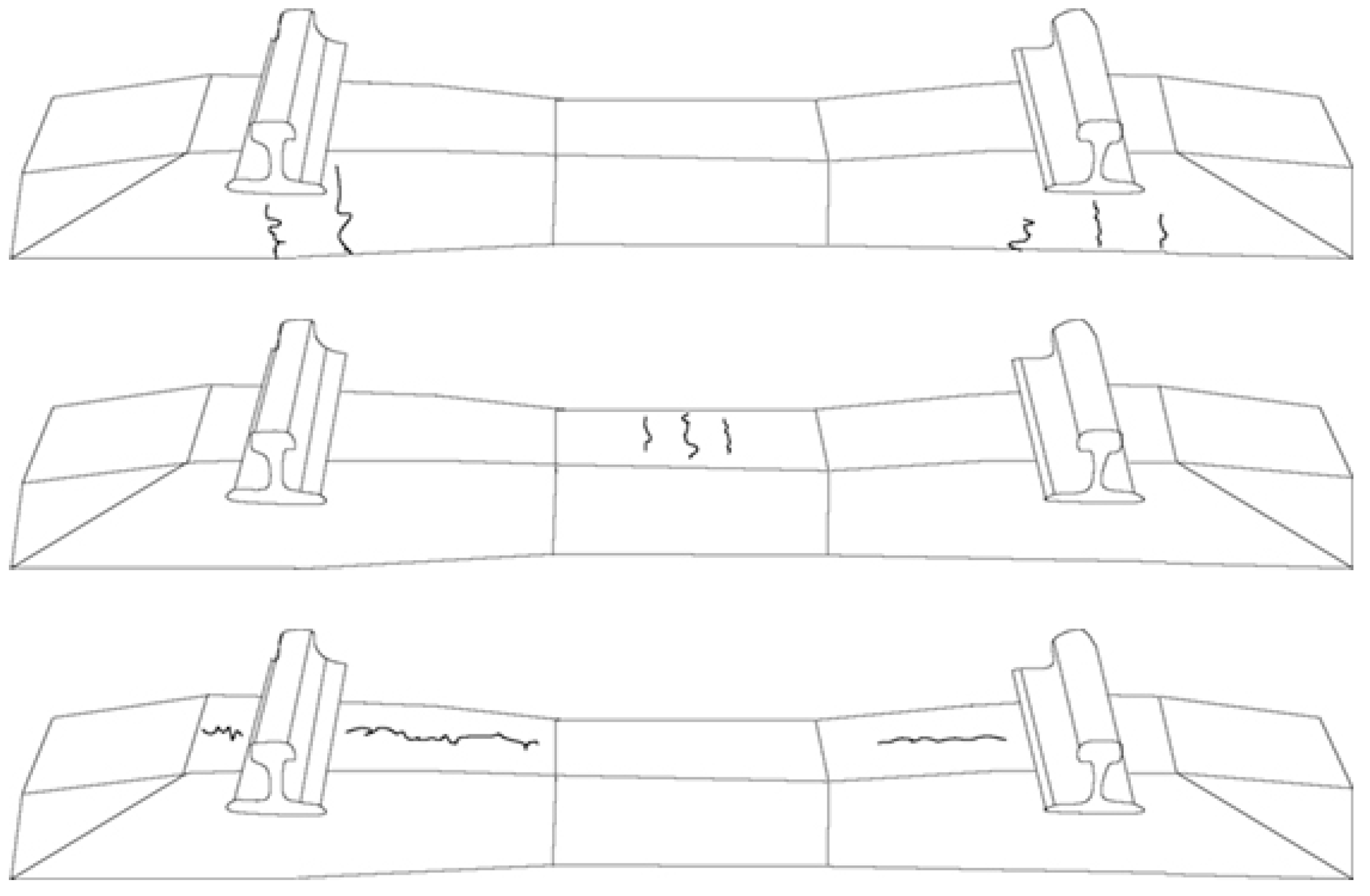




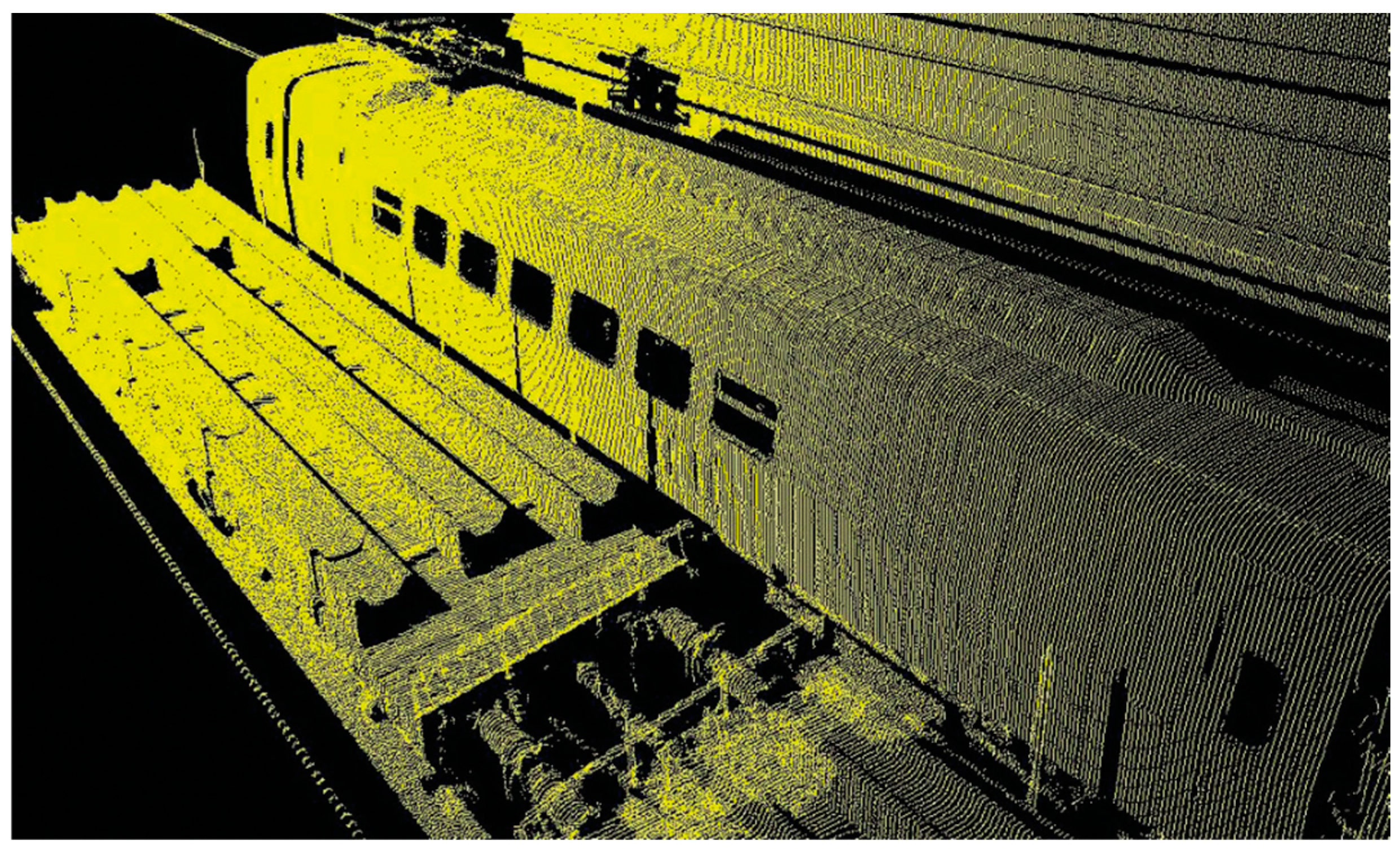
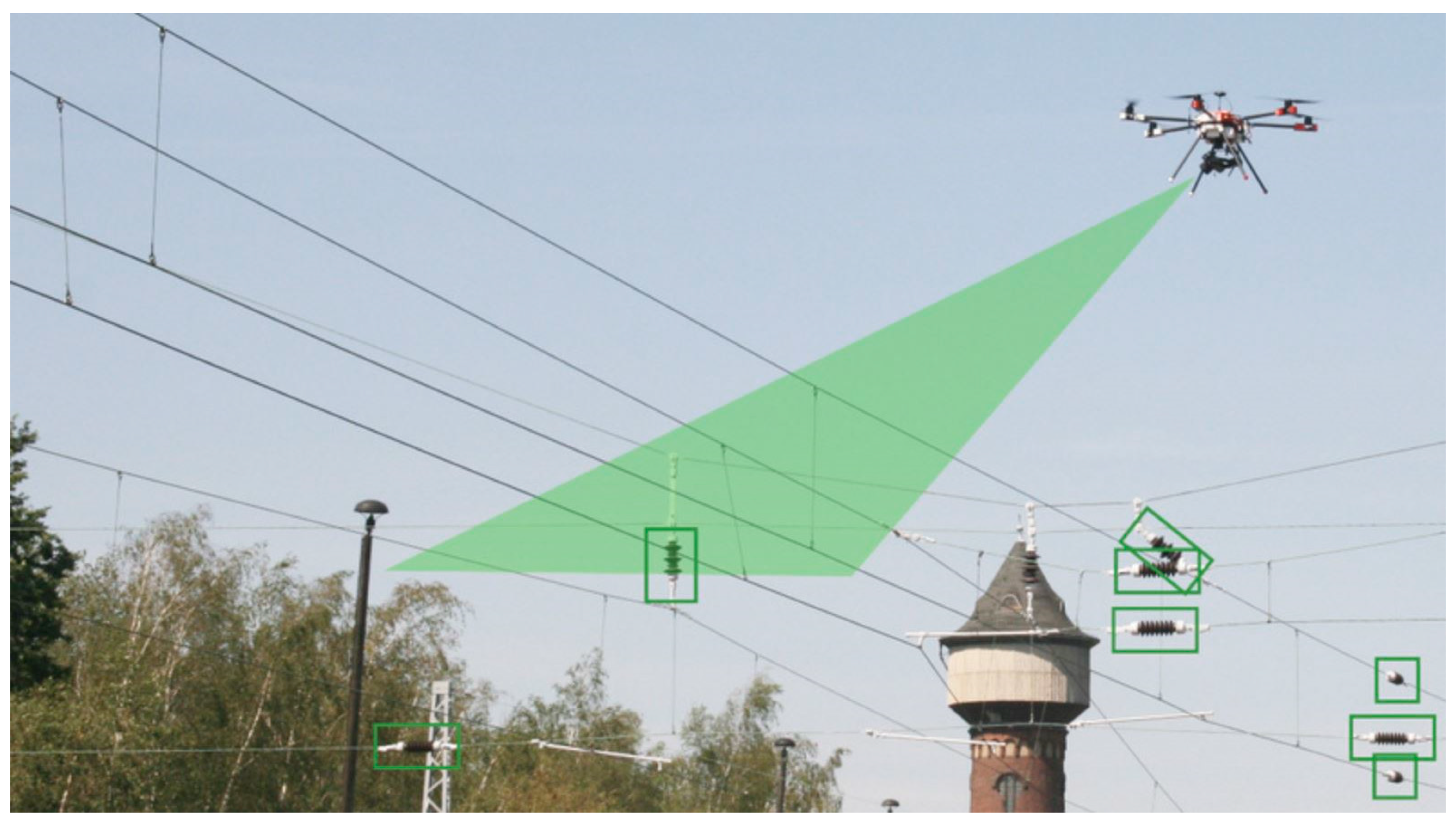
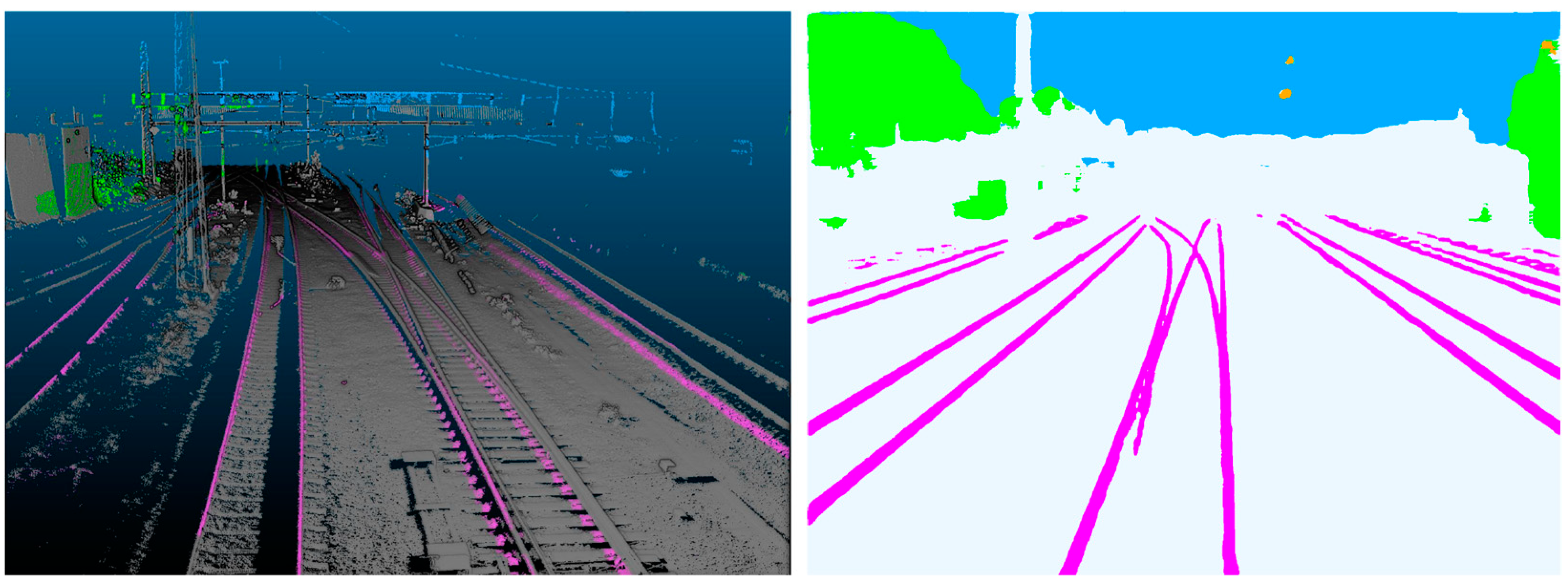
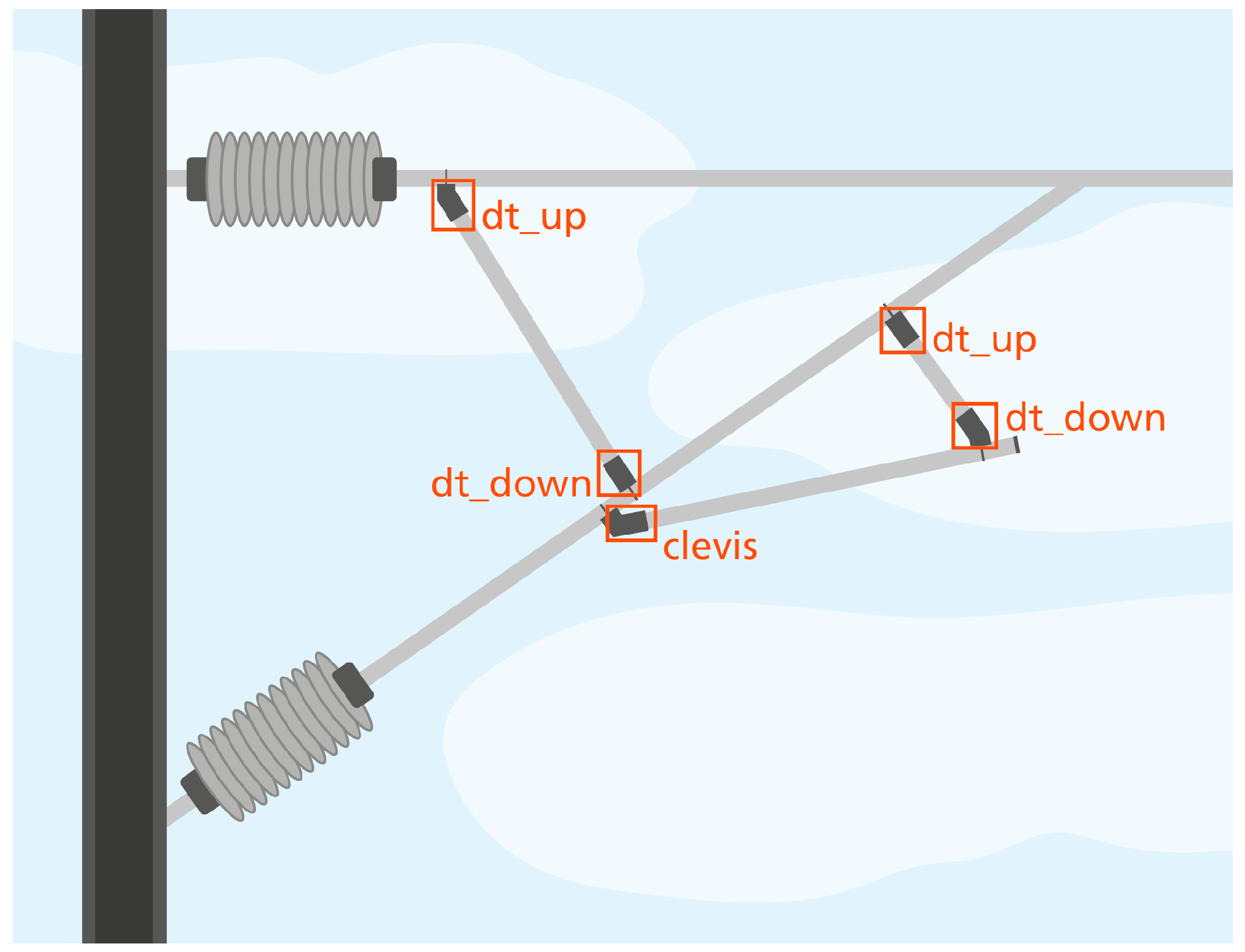

| Section | Monitoring Subjects | Suppliers | Measuring Systems (Optical Sensors Only) |
|---|---|---|---|
| Section 2.3.1 | Sleepers | bvSys [20] | Camera |
| MERMEC [21] | Camera and undefined sensors | ||
| Section 2.3.2 | Track | MERMEC [22] | LiDAR and undefined sensors |
| Fraunhofer IPM [23] | Camera and LiDAR | ||
| TVEMA [24] | |||
| SelectraVision [25] | |||
| Section 2.3.3 | Vegetation | bvSys [26] | Camera |
| Fraunhofer IPM [27] | |||
| Section 2.3.4 | Pantograph | SelectraVision [28] | Camera and LiDAR |
| Section 2.3.5 | Contact wire | bvSys [29,30] | Camera and LiDAR |
| MERMEC [31] | |||
| SelectraVision [25,32] | |||
| Fraunhofer IPM [33,34,35] | |||
| Section 2.3.6 | Pole | MERMEC [36] | LiDAR |
| Fraunhofer IPM [37] | |||
| Section 2.3.7 | Tunnel | Dibit [38] | Camera and LiDAR |
| MERMEC [39] | |||
| Pavemetrics [40] | |||
| TVEMA [41] | LiDAR | ||
| Fraunhofer IPM [42] | |||
| Section 2.3.8 | Clearance | MERMEC [39] | Camera and LiDAR |
| TVEMA [41] | LiDAR | ||
| Fraunhofer IPM [43] | |||
| RIEGL [44] | |||
| Zoller + Fröhlich [45] | |||
| Section 2.3.9 | Wheels | MERMEC [46] | Camera and undefined sensors |
| SelectraVision [47] | Camera and LiDAR | ||
| Section 2.3.10 | Rolling stock | MERMEC [48] | Camera and LiDAR |
| Fraunhofer IPM [49] | LiDAR |
Disclaimer/Publisher’s Note: The statements, opinions and data contained in all publications are solely those of the individual author(s) and contributor(s) and not of MDPI and/or the editor(s). MDPI and/or the editor(s) disclaim responsibility for any injury to people or property resulting from any ideas, methods, instructions or products referred to in the content. |
© 2024 by the authors. Licensee MDPI, Basel, Switzerland. This article is an open access article distributed under the terms and conditions of the Creative Commons Attribution (CC BY) license (https://creativecommons.org/licenses/by/4.0/).
Share and Cite
Zschiesche, K.; Reiterer, A. Optical Measurement System for Monitoring Railway Infrastructure—A Review. Appl. Sci. 2024, 14, 8801. https://doi.org/10.3390/app14198801
Zschiesche K, Reiterer A. Optical Measurement System for Monitoring Railway Infrastructure—A Review. Applied Sciences. 2024; 14(19):8801. https://doi.org/10.3390/app14198801
Chicago/Turabian StyleZschiesche, Kira, and Alexander Reiterer. 2024. "Optical Measurement System for Monitoring Railway Infrastructure—A Review" Applied Sciences 14, no. 19: 8801. https://doi.org/10.3390/app14198801






